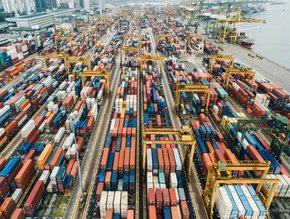What are procurement processes - and why are they key?

Procurement is essentially a vital business function that involves obtaining the goods and services a company needs to support its daily operations.
With the power to impact the bottom line, procurement can enable the company to get the supplies it needs, at the lowest cost and to deliver the most value that it possibly can.
In this article, we will explain what procurement processes are, how they work, what types of procurement exist and how to optimise them.
What are procurement processes?
Procurement processes are the set of steps and procedures that businesses use to acquire goods or services from external sources.
They cab vary greatly depending on each company’s structure and needs, but generally include the following core steps:
1. Identify which goods and services the company needs
First, a business must identify its requirements for a specific item or a service. This may involve consulting with staff across business departments, drafting a plan that includes cost, profitability, value and time estimates, or conducting market research.
2. Submit purchase request
Once the specific good or service required is clear, the procurement team can submit a purchase request to the proper department for review and approval. A purchase request is a document that specifies what is needed, why it is needed, when it is needed and how much it will cost.
3. Assess and select vendors
Next, the procurement team can research potential suppliers that can provide the desired goods or service. This may involve evaluating their reputation, quality, price, delivery time, availability and sustainability practices.
The procurement team can then select one or more vendors based on various criteria and negotiate terms and conditions with them.
4. Create a purchase order
After selecting a vendor and agreeing on terms and conditions, the procurement team can create a purchase order (PO), which is a formal contract that authorises the purchase of goods or services from a supplier.
A PO typically includes details such as quantity, price, delivery date, payment terms and other specifications.
5. Receive and inspect the delivered goods
When the supplier delivers the goods or services ordered by the PO, the procurement team can receive and inspect them to ensure they match the specifications and quality standards agreed upon.
If there are any discrepancies or defects, the procurement team can report them to the supplier and request a replacement or a refund.
6. Conduct three-way matching
Before approving payment to the supplier, the procurement team can conduct a three-way matching process, which involves verifying that the PO, the invoice and the receipt of goods or services are consistent and accurate.
This helps prevent overpayments, underpayments or fraud.
7. Approve the invoice and arrange payment
After confirming that everything is in order, the procurement team can approve the invoice from the supplier and arrange payment according to the agreed terms and conditions.
The payment method may vary depending on factors such as currency, location and preference of both parties.
8. Maintain records of all transactions
The last step in the procurement process is to keep records of all transactions related to each purchase order.
This includes documents such as purchase requests, POs, invoices, receipts and payment confirmations.
These records help track spending, monitor performance, ensure compliance and support audits.
What are types of procurement?
Procurement can be classified into different types based on various criteria such as:
The nature of goods or services procured: For example,
- Direct procurement
This refers to acquiring raw materials or components that are directly used in producing goods or services for customers.
- Indirect procurement
This concerns acquiring goods or services that are not directly used in production, but support business operations such as office supplies, utilities or travel expenses.
The level of involvement of internal stakeholders:
- Centralised procurement
This refers to having a single department or unit that handles all procurement activities for the entire organisation
- Decentralised procurement
This is all about having different departments or units that handle their own procurement activities independently.
Decentralised procurement can help increase flexibility, responsiveness and customisation to local needs and preferences.
- Hybrid procurement
Hybrid procurement refers to having a combination of centralised and decentralised procurement models.
This can help balance the advantages and disadvantages of both approaches and optimise efficiency and effectiveness.
How to optimise procurement processes?
Procurement processes can be optimised by applying various strategies and techniques, such as:
- Conducting regular spend analysis
Spend Analysis is about analysing historical and current spending data to identify patterns, trends and opportunities for improvement.
It can help reduce costs, improve quality, increase savings and enhance supplier relationships.
- Implementing strategic sourcing
This involves developing a long-term plan for procuring goods or services that aligns with the business goals and objectives. Strategic sourcing can help optimise value creation, reduce risks, foster innovation and achieve competitive advantage.
- Leveraging technology
In modern times, one of the most important steps, leveraging tech concerns using software tools or platforms that can automate, streamline and simplify procurement processes.
Technology can help reduce manual errors, increase transparency, improve collaboration and enhance decision-making.
Conclusion
Procurement processes are the backbone of any business that relies on goods and services to operate. They involve a series of steps that aim to find the best suppliers, negotiate the best terms and monitor the delivery and quality of the purchases.
They can be different depending on the nature and scope of the purchase, but all procurement processes share a common goal: to optimise processes, create value, and achieve business objectives.
Procurement is about more than just buying things; it is a strategic way of managing resources and enhancing performance, and in that, it is indispensable to any business.
- European Commission unveils agile IT procurement processDigital Procurement
- Hutchinson selects Ivalua's eProcurement for optimisationIndirect Procurement
- Transforming a tactical cost centre with procurement techProcurement Strategy
- Understanding indirect category management to manage spendIndirect Procurement






